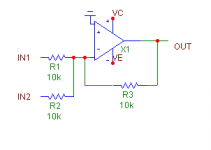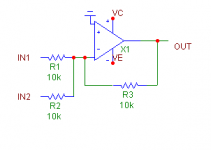i`ve done a simple non inverting buffer by shorting the output and the - input having the signal go into the + input. the input is clamped with a 100k resistor to ground. i am using an opa2132 opamp
because i want to sum the both stereo channels for my sub woofer, i put the 2 channels on 2 different opamps and integrate them with 2 100R resistors at the output.
i have experienced a great loss in signal. before implementing the buffer, i had more then enough gain. now i don`t. infact the loss is quite high. i`ve tried changing the 100R resistors to 10k but the situation does not improve. in addition to that. i have got humming now.
can anyone enlighten me to the cause of my misery?
Thank You in advance!!
because i want to sum the both stereo channels for my sub woofer, i put the 2 channels on 2 different opamps and integrate them with 2 100R resistors at the output.
i have experienced a great loss in signal. before implementing the buffer, i had more then enough gain. now i don`t. infact the loss is quite high. i`ve tried changing the 100R resistors to 10k but the situation does not improve. in addition to that. i have got humming now.
can anyone enlighten me to the cause of my misery?
Thank You in advance!!
Put a 5k resistor at the output of each. Let these both join at the input of a third op amp's + input with 100k to ground and output shunted to - input. That would be one of the several "proper" ways to sum signals.
Some loss in signal could come from the fact that signals that are out of phase between the channels, will cancel when summed.
Now, most deep bass usually is recorded mono, therefore in phase between channels, and will add without loss. If you do experience great loss in the bass, that means one of your inputs likely is wired with inverted polarity, therefore 180 degrees out of phase.
I always wanted to know how to obtain a correct mono mix from two stereo channels, because in the higher frequencies, anything randomly out of phase will cancel in a summing amplifier. If you sum stereo to mono but out of phase, you recover the ambient signal, which is the operating principle of some surround processors. Concurrently, it is noticeable how much you lose in ambient signal when you sum things in mono the conventional way... any thoughts?
Some loss in signal could come from the fact that signals that are out of phase between the channels, will cancel when summed.
Now, most deep bass usually is recorded mono, therefore in phase between channels, and will add without loss. If you do experience great loss in the bass, that means one of your inputs likely is wired with inverted polarity, therefore 180 degrees out of phase.
I always wanted to know how to obtain a correct mono mix from two stereo channels, because in the higher frequencies, anything randomly out of phase will cancel in a summing amplifier. If you sum stereo to mono but out of phase, you recover the ambient signal, which is the operating principle of some surround processors. Concurrently, it is noticeable how much you lose in ambient signal when you sum things in mono the conventional way... any thoughts?
The inverting summer is more or less ideal. A non-inverting summer has losses, by nature.PMA said:You might try attached image for summing.
Peranders,
How does it have any more inherent losses than the noninverting one (other than ones easily corrected by the gain setting)?
I am naturally more inclined to inverted operation but here I don't see why the result would be much different.
A non-inverting summer has losses, by nature.
How does it have any more inherent losses than the noninverting one (other than ones easily corrected by the gain setting)?
I am naturally more inclined to inverted operation but here I don't see why the result would be much different.
OK, I follow so far and I also think the inverting one has more elegance to it.
But say, if one uses two noninverting unity gain buffers to drive a noninverting summing third op amp, through 5k isolation resistors, as I described earlier - are there going to be any real world interferences between the two source op amps?
But say, if one uses two noninverting unity gain buffers to drive a noninverting summing third op amp, through 5k isolation resistors, as I described earlier - are there going to be any real world interferences between the two source op amps?
Most probably no. To be frankly, I have only read the first post (question about summing) at first.
Speaking about inverting amp - it is not ideal, too. Depending on opamp's slew rate there will be errors for very steep signals, might resulting in input stage distortion. But this is completely different story .
.
Speaking about inverting amp - it is not ideal, too. Depending on opamp's slew rate there will be errors for very steep signals, might resulting in input stage distortion. But this is completely different story
PMA said:You might try attached image for summing.
thanks for the attachment but won`t the both channels be mixed throughout the system as the 10k resistors are small compared to my amp`s 100k input Z?
ACD said:Why don't you just use the sumamp circuit and add another inverted opamp on the output of the first.... The you are back "in phase"
I was expecting that everybody understand this what you have described
PMA said:every device sees input impedance of precisely 10k. The signals will be just only added. 10k resistors are connected to the -input of the opamp. There is maintained zero voltage (virtual ground).
Wrong !
Both will se 10K + 10k//100K. This will in effect be "divide by 2" circuit. The "summing" OPAMP will get half the signal from each input OPAMP.
One way of saving it all, if you still wish to use this against all good advice from my countryman, was to make the "summing OPAMP" amplify by 2.
boholm said:
Wrong !
Both will se 10K + 10k//100K. This will in effect be "divide by 2" circuit. The "summing" OPAMP will get half the signal from each input OPAMP.
One way of saving it all, if you still wish to use this against all good advice from my countryman, was to make the "summing OPAMP" amplify by 2.
I speak about inverting circuit as I shown the schematics before. For once more (next post shows circuit):
- Status
- This old topic is closed. If you want to reopen this topic, contact a moderator using the "Report Post" button.
- Home
- Amplifiers
- Solid State
- Summing Channels with opamps


 Oops . . made a false assumption.
Oops . . made a false assumption.